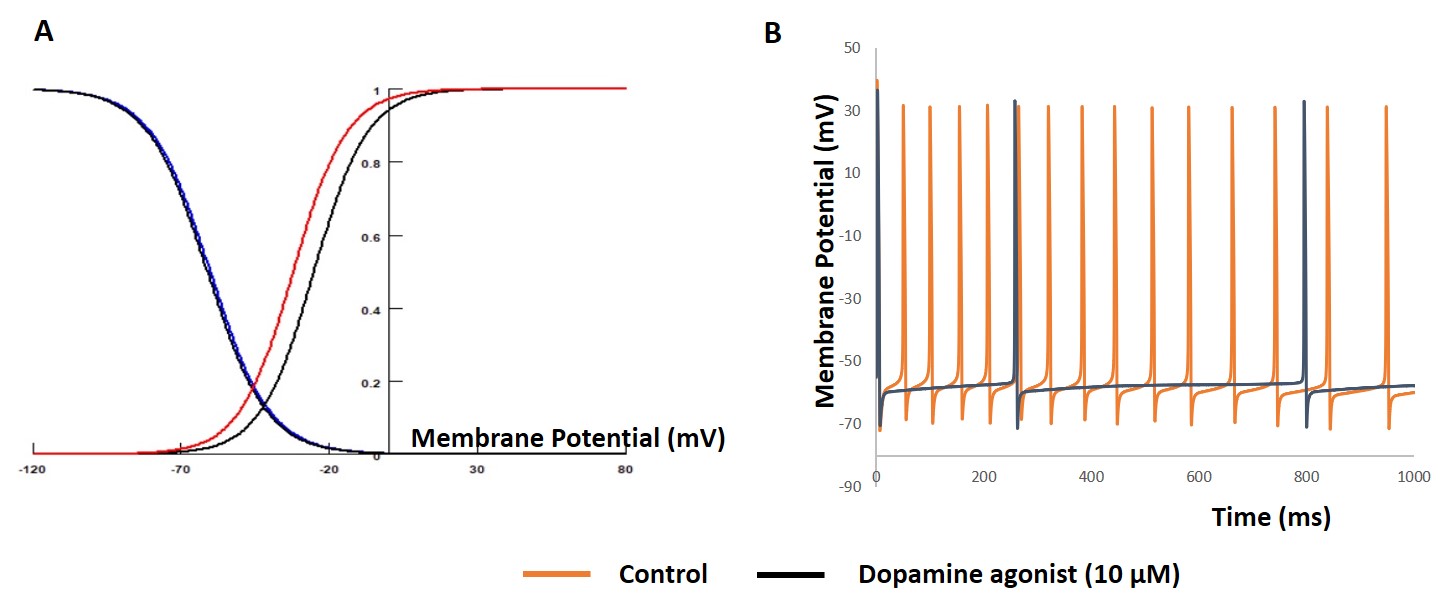Category: Neuropharmacology
Objective: Recent experimental data suggest a putative coupling between dopamine D2 receptors (D2R) and T-type Ca2+ channels as another biophysical explanation for the firing pattern modulation layer II of the medial entorhinal cortex (MEC) [1]. This study aims to unfold the subcellular D2R and T-type Ca2+ channels pathway mechanisms and their modulating effects on resting membrane potential (RMP) and action potential (AP) in the Parkinson’s Disease (PD) condition.
Background:
The pathogenesis of PD is associated with dopamine concentration, dopamine receptors, and electrical firing patterns of the stellate cells in layer II of the MEC.
Method: This study model is established in three folds. First, the biophysical parameters for various ion channels in the layer II stellate cells were combined and adapted from previous models and experimental studies. Second, we developed equations for the GPCR pathway to alter the cAMP concentration, which was merged with the maximum conductance of T-type Ca2+ channels in a changed Boltzmann equation. Third, various pharmacological agents are simulated to explore new biological insights from our model.
Results: The dopamine agonist bromocriptine (Bromo) of 10 µM is mimicked to investigate the altered internal kinetics of the T- type Ca2+ channel. Then the APs are evoked from the whole cell model. Figure 1 (a) illustrates the modulating effects of Bromo on the steady-state activation and inactivation curves of the T-type Ca2+ channel. It shows approximately zero effects on the steady-state inactivation curve, but a positive shift on the steady-state activation curve (black solid line). As a result, the half activation potential of the T-type Ca2+ channel is shifted from –36 mV to –32 mV. Figure 1 (B) demonstrates the effects of a dopamine agonist on the simulated AP generation with a current injection of 400 pA for a duration of 1 s. It clearly shows the reduced AP frequency (black solid line) under the effects of the dopamine agonists. The window current to maintain the RMP was reduced because of the activation of D2R receptors and it was counterbalanced by decreasing the A-type K+ channel conductance.
Conclusion: This in silico study suggests that the application of cAMP antagonists and K+ channel agonists could be used to replace dopamine in certain pathological conditions like PD and in studies of spatial memory performance.
References: [1] Jin, X., Chen, Q., Song, Y., Zheng, J., Xiao, K., Shao, S., … & Huang, Z. (2019). Dopamine D2 receptors regulate the action potential threshold by modulating T‐type calcium channels in the stellate cells of the medial entorhinal cortex. The Journal of Physiology, 597(13), 3363-3387.
To cite this abstract in AMA style:
C. Mahapatra, A. Pradhan. Quantitative investigation of the pathway between dopamine receptors and Ca2+ channels in layer II stellate cells towards Parkinson’s disease [abstract]. Mov Disord. 2023; 38 (suppl 1). https://www.mdsabstracts.org/abstract/quantitative-investigation-of-the-pathway-between-dopamine-receptors-and-ca2-channels-in-layer-ii-stellate-cells-towards-parkinsons-disease/. Accessed December 27, 2025.« Back to 2023 International Congress
MDS Abstracts - https://www.mdsabstracts.org/abstract/quantitative-investigation-of-the-pathway-between-dopamine-receptors-and-ca2-channels-in-layer-ii-stellate-cells-towards-parkinsons-disease/

